Tadoussac, Quebec 作者: 来源: 发布时间:2021-12-08
I.Population and Area
-Area
•Land: 194.10 km2 (74.94 sq mi)
-Population (2016)
-Total: 799
-Density:14.8/km2 (38/sq mi)
II.Natural Geography (environment and resources)
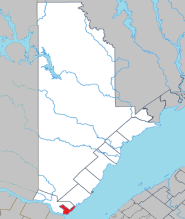
-Tadoussac is a village in Quebec, Canada, at the confluence of the Saguenay and Saint Lawrence rivers. The indigenous Innu called the place Totouskak (plural for totouswk or totochak) meaning "bosom", probably in reference to the two round and sandy hills located on the west side of the village. According to other interpretations, it could also mean "place of lobsters", or "place where the ice is broken" (from the Innu shashuko). Although located in Innu territory, the post was also frequented by the Mi'kmaq people in the second half of the 16th century, who called it Gtatosag ("among the rocks"). Alternate spellings of Tadoussac over the centuries included Tadousac (17th and 18th centuries), Tadoussak, and Thadoyzeau (1550). Tadoussac was first visited by Europeans in 1535 and was established in 1599 when the first trading post in Canada was formed there, in addition to a permanent settlement being placed in the same area that the Grand Hotel is located today.
-Tadoussac is located on the north-west shore of the Saint Lawrence River, at its confluence with the Saguenay River. The cold, fresh water from the Saguenay and the warmer, salty water of the St. Lawrence, meet to create a rich marine environment. The rivers support an abundance of krill, making the area very attractive to whales.
III.ECONOMY
-Average in Tadoussac, QC: $14.46 per hour
-Website: https://ca.indeed.com/salaries/plongeur-Salaries,-Tadoussac-QC
IV.Industrial Characteristics
-Tadoussac, lying at the confluence of the Saguenay and Saint Lawrence rivers, possesses a rich natural and cultural heritage. Originally a site for trade between Amerindian nations, it was later frequented by Basque, Breton and Norman fishermen. Its first permanent settlements were built in the first third of the seventeenth century. Tadoussac became New France's most important port, and the main trading post of the huge Domaine du Roi. Later, with industrialization and development of the region, its economic and touristic value grew. With its magnificent countryside, natural resources and history, Tadoussac makes its mark on land and on sea, as seen by the numerous heritage events still taking place today.
-Tadoussac enjoys a choice location. For centuries, it has attracted travellers, and it is still highly esteemed for its cultural and historical interest and for the opportunities it offers tourists and vacationers. Although the built heritage is no longer standing, some knowledge of history allows tourists visiting these sites to recreate the past in imagination, and to absorb the atmosphere of times gone by. A walk might lead to some half-hidden ruins, and spirits of ancient human presence may be evoked near the Centre des loisirs or at sites between Tadoussac and the Moulin-à-Baude dunes (NOTE 1), such as the Hovington farm lands, formerly called the Delporte farm.
-Human presence in Tadoussac goes back thousands of years. At the end of the Wisconsin glaciation about 10,000 years ago, melting snow and retreating waters on the North American continent gradually gave way to returning life: flora, fauna, and then human groups in search of food. Archeological excavations in the area around Tadoussac, which became accessible 2000 to 4000 years BCE, have revealed a great number of stone artifacts. Some of the objects from prehistoric times are now stored at the Quebec Ministry of Cultural Affairs in Quebec City.
-Aside from stone artifacts, pottery with Iroquoian motifs has been found near the mouth of the Moulin-à-Baude River. This discovery corresponds to observations made by Jacques Cartier on his second voyage in 1535. Other reports from the 1540s, in Cartier's writings and in the judicial archives of the Basque country of Spain, suggest that the whole north shore of the Saint Lawrence River and of the Gulf of Saint Lawrence as far as Newfoundland, as well as the south shore as far as Gaspé, were frequented in summer by groups of Iroquoians from the greater Quebec region on hunting and fishing expeditions. There were not yet any Innu or other Amerindian nations there.
-Website: http://www.ameriquefrancaise.org/en/article-677/Tadoussac_between_Forest_and_Sea.html
V.Attractions
1.Teensy Tiny Chapel
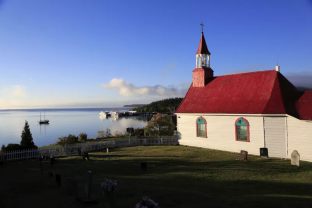
-Built in 1747 by the Jesuits, Petite Chapelle is one of North America's oldest wooden churches. Built by Jesuit missionaries as part of their efforts to convert the indigenous peoples to Christianity, the chapel is also known as the Indian Chapel and it contains a small exhibition on missionary life.
-Pay what you like to visit this little slice of French Canada's past. There's usually a nice lady inside to help interpret the building and its history for you.
-Website: http://chapelledetadoussac.com/
-Address: Tadoussac, QC G0T 2A0, Canada
2.WHALE-WATCHING TOURS
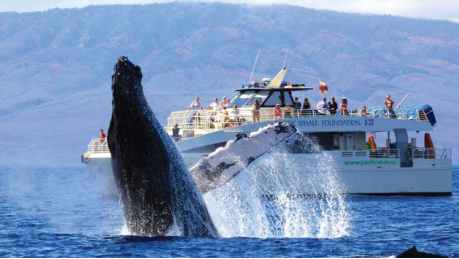
-Tadoussac is known as one of the best places in the world for whale watching. Passengers often see two or three marine mammal species, sometimes more, in a two- or three-hour tour. Embark on a tour boat to observe these giants and live an unforgettable experience.
-A dozen whale species visit the Lower Estuary. Some are abundant, while others are endangered and can only be observed from a distance of 400 m. Rorqual whales (minke whales, humpback whales, fin whales and blue whales) come here to feed over the summer from May to October. The beluga whale is the only cetacean species to live in the St. Lawrence year round.
-The first whale-watching excursions were organised in the Tadoussac and Les Bergeronnes area in 1979. This activity eventually expanded to the point where it now represents a major portion of the regional tourism offering and socioeconomic livelihood.
-The region where Charlevoix meets the Saguenay Fjord is rich in marine life and one of Canada's most popular whale watching spots.
-The Saguenay River's mix of Atlantic Ocean salt water and inland fresh waters cultivates a thriving krill population, which creates an optimal environment around Tadoussac for a host of marine animals, including fin, minke, blue, and beluga whales.
-You can see the whales here in many ways. A cruise on the river will give you a firsthand look at many varieties of whales from deeper waters. Many cruises offer not only the chance to see whales but also trained naturalists who can help you understand these creatures even better, whether on a larger excursion boat (holds 100+ people) or smaller, more nimble zodiac (room for 5 to 12).
-Book ahead online, certainly the best strategy in summer months, or arrive and take your chances. The two main cruise companies are Otis and Croisieres AML.
-Another way to see the whales is actually from the shore of the town. From many vantage points, it’s possible to look out and see smaller whales like minkes and belugas. For the truly adventurous, take a kayak on the waters for a more intimate whale watching experience.
-ADDRESS:431 Rue du Bateau Passeur, Tadoussac, QC G0T 2A0, Canada
-PHONE +1 418-235-4197
3.the Sentier de la Pointe-de-l'Islet Trail
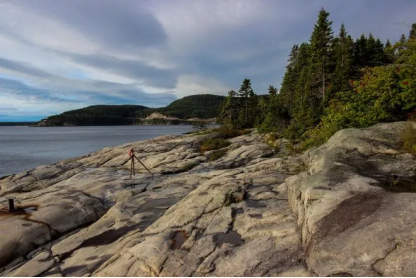
-Though the majority of tourists come to Tadoussac for whale watching and rarely leave the harbour's immediate vicinity, it's worth taking the time to explore a bit of the area for a wider take on the town.
-One walk definitely worth taking is along the boardwalk and well-marked Sentier de la Pointe-de-I'Islet Trail. Not strenuous or technical, this natural, rocky hike is suitable for kids or mobile seniors.
-The trail starts to the left of the Marine Mammal Interpretation Centre up a flight of stairs, where you head into woods but shortly pop out onto a rocky bank overlooking the bay.
-Bring a jacket or sweater so that you are comfortable stopping to appreciate the views - as it can be chilly and windy next to the water. If you are lucky, you may even see some passing minke or beluga whales.
4.Leaf Peep in Fall
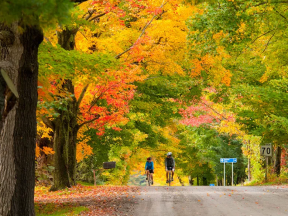
-Eastern Canada is fall foliage central, so come the end of September through October, the Quebec trees, especially the maples, are ablaze in orange, gold and crimson.
-Tadoussac, which sits where the Saguenay and Saint Lawrence rivers meet and has a backdrop of undulating forested hills, is a visual feast during autumn.
-For more intense colours, keep heading west to Quebec City or Montreal. The best colours tend to be around there, in, for example the Laurentians or the Eastern Townships.
VI.History
-Jacques Cartier came to the site in 1535 during his second voyage. He found Innu people using it as a base for hunting seal. Later that same century, Basques conducted whaling expeditions on the river.
-Tadoussac was founded in 1599 by François Gravé Du Pont, a merchant, and Pierre de Chauvin de Tonnetuit, a captain of the French Royal Navy, when they acquired a fur trade monopoly from King Henry IV. Gravé and Chauvin built the settlement on the shore at the mouth of the Saguenay River, at its confluence with the St. Lawrence, to profit from its location. But the frontier was harsh and only sixteen of the initial 50 settlers survived the first winter. In 1603, the tabagie or "feast" of Tadoussac reunited Gravé with Samuel de Champlain and with the Montagnais, the Algonquins, and the Etchimins." In 1615, the Mission of L'Exaltation-de-la-Sainte-Croix-de-Tadoussac, named in memory of a cross planted by Jean de Quen, was founded by the Récollet Order. Their missionary brothers sang the first Mass there two years later.
-Tadoussac remained the only seaport on the St. Lawrence River for 30 years. Historians believe the St. Lawrence Iroquoians, who inhabited the St. Lawrence valley upriver to the west, were defeated and pushed out by the Mohawk before the early 17th century. By the late 17th and early 18th century, Tadoussac was the centre of fur trade between the French and First Nations peoples. Competition over the fur trade increased among the nations. Colonists from the Tadoussac area were involved in whaling from 1632 until at least the end of the century.
-In the 19th century, with industrialization reaching other parts of Canada, tourists discovered the appeal of this rural village. Wealthy Québécois built a number of vacation villas. A Victorian hotel called the Hotel Tadoussac was built in 1864; it was expanded around 1900 and demolished in 1942, and replaced by a newer Hotel Tadoussac.
-In 1855, the geographic township of Tadoussac was established. In 1899, it was incorporated as a village municipality. In 1937, the Parish Municipality of Tadoussac was formed, but dissolved in 1949 because it had less than 500 inhabitants.
VII.Other information
-Located on a spectacular bay, at the entrance of the majestic Saguenay Fjord, Tadoussac is most famous for its whale-watching tours, which have been operating since 1979. Nevertheless, this special geographical site has a long history. For centuries, it was an Amerindian hub. In the 16th century, it was a haven for European whalers. The reconstruction of the Chauvin house, erected in 1600, gives visitors a glimpse of the time when Tadoussac was a major fur trading post. Built in 1747, the Chapelle des Indiens also evokes the years‑long mission to evangelize Amerindians. The beautiful villas and luxurious hotel that add to the village’s charm are from the 19th and 20th centuries, when Tadoussac was a very popular holiday destination. Every summer for more than 30 years, the Festival de la Chanson has been offering Francophone programming in a festive, almost family-like atmosphere. Tadoussac has always had a lot to offer those who were passing through.
-Website: https://corridorcanada.ca/resource/tadoussac/?lang=en
VIII.Contact information
-Government
•Mayor: Charles Breton
•Federal riding: Montmorency—Charlevoix
—Haute-Côte-Nord
Contact Information
-Address: 197, rue des Pionniers, Tadoussac (Québec) G0T 2A0 Canada
-Telephone:
•Summer: 418 235-4744, extension 7 or 1 866-235-4744
•Winter: 418 235-4744, extension 6 or 1 866-235-4744
-Fax:
•Summer: 418 235-4984
•Winter: 418 235-4433
-Email: tourisme@tadoussac.com
